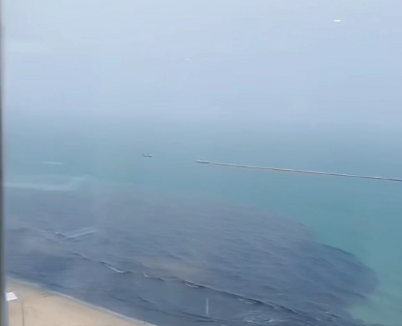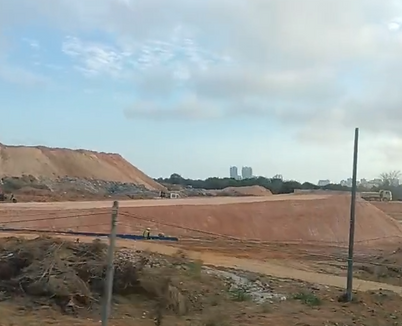Humans of Shenzhen
Old Growth Forests
Polluting industries and poor policies often damage our environment while exposing workers to health risks. The logging industry, urban sprawl, and infrastructural development are threatening South China's subtropical and tropical old-growth forests. "Old Growth Forest" documents and publicizes photographical captures of disrupted forest ecology in South China to expose these industries' unsustainable, exploitative practices, and urge for administrative protection of these ecologically diverse and important forests.
Initaitive
Accessible guidelines towards sustainable lifestyle based in schools and communities. Exploring the challenges of Shenzhen's garment workers.
Members
BIPH ESG Club, BNDS Sustainability Club, SCIE SDGs Club, MHIS MUN Club, etc.

What we see on our school bus...
What can you see on a two-hour journey on a school bus? For South China students, we see: Old-growth forests clearcut, Reservoirs depleted, Lakes dried up, Waste dumped into oceans. Artificial lakes eutrophicated, Soil barren and eroded, leaving us with nothing but a heavy heart full of sorrow for our "silent spring."
As South China students, we've documented how nature has been losing ground over half a decade. And we invite you to join us as witnesses.
.png)
Jingxing Reservoir, Spring 2024 (satellite image)
Jingxin Reservoir Drinking Water Source Protection Area is located in the Kuichong Street of Dapeng New District. According to Shenzhen with a normal water level of 104.00 meters and a protected area of 9.94 square kilometers.
_edited.jpg)
Jingxing Reservoir, Nov. 2024
The 104-meter high water level of the Jingxing Reservoir has been declining since 2022. As of November 2024, all of the 2.58 square kilometers of the Jingxing reservoir has dried up entirely, leaving bare land beneath.
.png)
Forested hillside near Xiajingxin village, Spring 2024 (Satellite image)
Part of a large subtropical, mountainous forest beside Xiajingxin village, this hillside is located near a large battery factory and a major drinking water reservoir.
_edited.jpg)
Forested hillside near Xiajingxin village, Nov. 2024
The forested area around the battery factory was often disrupted and destroyed, for waste disposal or building construction. Most recently, this part of the forest is clearcut.
.jpeg)
Forested hillside near Xiajingxin village, Spring 2024 (Satellite image)
Part of a large subtropical, mountainous forest beside Xiajingxin village, this hillside is located near a large battery factory and a major drinking water reservoir.
_edited.jpg)
Forested hillside near Xiajingxin village, Nov. 2024
The forested area around the battery factory was often disrupted and destroyed, for waste disposal or building construction. Most recently, this part of the forest is clearcut.
.jpeg)
Eutrophic pond near Baguang village, Spring 2024 (Satellite image)
Originally a reservoir beside a discarded forest farm, the artificial lake in this image saw a progressive decline in its water level since 2022. A still body of water without flow/currents, the pond quickly became eutrophic due to the accumulation of nutrients -- occupied by algae and bacteria that consumes and depletes oxygen, suffocating fish species and making the pond ecologically dead. The brownish-green color of the pond comes from algae that grow on top of the pond, blocking sunlight and killing the plants beneath.
_edited.jpg)
Eutrophic pond near Baguang village, Nov. 2024
Unfortunately, the eutrophic pond seems to be growing in size over the summer of 2024, in part because of heavy precipitation in the coastal region. This expansion enlarges the benthic zone (the muddy bottom of the pond, where anerobic bacteria and worms break down dead bodies of fish and plants, releasing CO2 in the process). The algae floating on top of the pond blocks sunlight, while the water from the pond drowns the grass and other plants that's rooted beneath, changing flourishing forest ecology into dead zones.
.png)
Forested hillside near BAK factory, Spring 2024 (Satellite image)
The bare strip of land shown in the satellite image sits on top of a steep hillside that was created when forested land was cleared for highway construction beside. Human activity and steepness of the slope has stripped the land off its vegetation and nutrient-rich topsoil, leaving dry soil that can't support plant growth beneath. This makes the piece of land especially prone to erosion, as rainwater could easily wash away soil from the steep slope lacking vegetation cover. This runoff of sediments lead to pollution in valley regions.
.jpeg)
Forested hillside near BAK factory, Nov. 2024
Heartwarmingly, ongoing reforestation efforts have restored parts of the mountainside's plant cover. The cover plant, though unable to support as diverse an ecosystem as the forest that originally sat here, prevents soil erosion from wind and rain. Started in 2021, reforestation finally yielded concrete results in 2024 -- an impressive accomplishment considering how eroded and depleted the bare soil was before reforestation started. However, on the left side of the hillside, more areas of the forest are newly cleared for unknown purposes. Left bare, reforesting the clearcut land will be extremely difficult.

Forested valley near BAK factory, Spring 2024 (Satellite image)
Located near a small, densely populated industrial "edge city" of Shenzhen, this valley has been deforested and reforested time and again. Parts of the hillside, for example, have been cleared for vegetable cultivation, which this forested piece of land was clearly unequipped to support --- given the slope of the terrain, the factory's waste discharge, and Shenzhen's subtropical environment, all of which leaves it vulnerable to soil depletion. Young trees were planted, three years ago, along the slope immediately in front of the factory gate. The trees barely had time to grow into a forest cover when a new construction started at the bottom of the valley, marking the start of another disruption to this beleaguered site.

Deforested valley near BAK factory, Jan. 2025
Stripped of its forest cover by what seems to be a new construction project, the soil in this valley had turned from a healthy, rich dark brown to this infertile pale yellow over a few weeks. This is suggestive of its top soil losing moisture and becoming more easily eroded, driving up particulate matter concentration in air. For tropical and subtropical forests like this one in Guangdong, organic matter cycle through the ecosystem quickly, as ample sunlight and precipitation speed up the growth of plants, which consumes soil nutrients, and the decomposition of dead organisms that resupplies molecules. Thus, the rich top soil is quickly depleted once the forest cover is cleared, as the deforested area effectively becomes an ecological desert and as the carbon cycle is disrupted.

Huizhou Daya Bay Petrochemical Development Zone, Spring 2024 (Satellite image)
The tree-covered area surrounding this huge state-owned Petrochemical factory has been intermittently cleared for reasons unannounced, though the barren land created had been visibly used for waste disposal and facility expansion. Notably, this sizable facility, which occupies 6.98 square kilometers (over 1,700 acres) of land, had been seen emitted thick, dark exhaust that can cover the sky and block sunlight multiple times. In a few instances, uncontrolled fire came out from the exhaust pipes, dyeing the sky red. While gas flaring, using fire to burn off unwanted flammable gas, is a standard practice, the brightness of the fire of the color of the exhaust are both suggestive of abnormalities.

Huizhou Daya Bay Petrochemical Development Zone, Jan. 2025
The mound in this picture, which blocks off the sight of the factory's long line of exhaust pipes standing behind, was nonexistent a few years ago. In the place of this mound, there used to stand a natural barrier of trees buffering the factory from apartments complexes on the other side of the highway
Following the similar pattern, a sizable track of land was stripped of its tree cover, and as excavators and bulldozers level a portion of the cleared land, they left unwanted rocks and other materials just beside. Not only is this heap of small rocks and waste matter vulnerable to runoff, given Southeastern China's characteristic wind and heavy rain, it also blocks the fertile top soil that remains of deforested land, impeding primary succession.

Park Lane Harbor Beach, Daya Bay, Huizhou, Spring 2024 (Satellite image)
Xiaojing Bay in Park Lane Harbor attracts large numbers of tourists throughout the year. Nicknamed Chinese Maldives, Xiaojing Bay in Park Lane Harbor is known for its sunny weather, cerulean sea, and charming beach. The beach is lined with hotels, followed by apartments, all built as part of a planned community. As with many popular beaches, some tourists leave garbage on the beach, and numerous voluntary initiatives aim at cleaning the beach.

Park Lane Harbor Beach, Daya Bay, Huizhou, Feb. 2025
Various voluntary environmental groups, many from nearby schools, keep the beach relatively free of plastic waste. But at times, dark or colored water flows out of hidden discharge pipes, as in this picture taken from a hotel room, which captures a part of the ocean dyed dark from unknown discharge. Aside from the tourism industry, most residents of the Daya Bay District are employed by its Petrochemical factories or nuclear power plants, both of which raise environmental concerns (though in theory, nuclear power is one of the cleanest non-renewable source of energy).

Deforested mound near Shangjiao village, Xiachong, Huizhou, Spring 2024 (Satellite image)
Shangjiao village is surrounded by mounds and small hills characteristic of the mountainous, subtropical Guangdong. Historically, they act as barriers blocking the reach of infrastructure and other facilities. With China's impressive large-scale state-funded infrastructural projects, however, forests were cleared and mounds were blasted to make ways for roads.

Deforested mound near Shangjiao village, Xiachong, Huizhou, Jan. 2025
Mounds beside the Shangjiao village have been cleared and leveled for what appears to be an extensive infrastructure project involving multiple connected bridges and roads. Shown beside the scattered utility poles are dead branches from uprooted bushes and trees. The pale, light color of the exposed dirt pile suggests that the soil's dark top level and the organic layer beneath have both been removed.

Deforested hillside near Jingxinhe Bridge, Spring 2024 (Satellite image)
This hillside is located along the Hui-Shen Coastal Expressway, which, completed in 2010, connects the metropolis Shenzhen to surrounding cities like Huizhou. The dead plant remains lying on the ground speaks to how this highway's construction visibly disrupted the ecosystem. But the environmental impact of highways is not limited to the surface. As World Rainforest Movement (WRM) writes, ”the opening of access and other roads also aids in the expansion of the agro-industrial frontier and other threats to forests—such as illegal logging or small-scale mining. That is, infrastructure not only directly causes deforestation, but also facilitates the entry of other industries into forests."

Deforested hillside near Jingxinhe Bridge, Feb. 2025
WRM's warnings are regrettably emblematic of what has occurred along the Hui-Shen expressway over the past half a decade. The hillside shown in this picture was cleared and paved with concrete in preparation of a new road. As the original highway eased transportation and opened access, edge cities and small communities developed along the way. The city periphery's lower land cost attracted factories to migrate, while newer tech startups chose cheap coastal office buildings along the convenient highway as their workplace. Real estate developments also exploited this juxtaposition of hills, cliffs, and the ocean, easily accessible with cars. This suburbanization of both residents and corporations led to more infrastructure projects, fueling a vicious cycle.
Check back soon
We update this webpage iteratively. Please revisit this site to allow us to share with you our new findings!